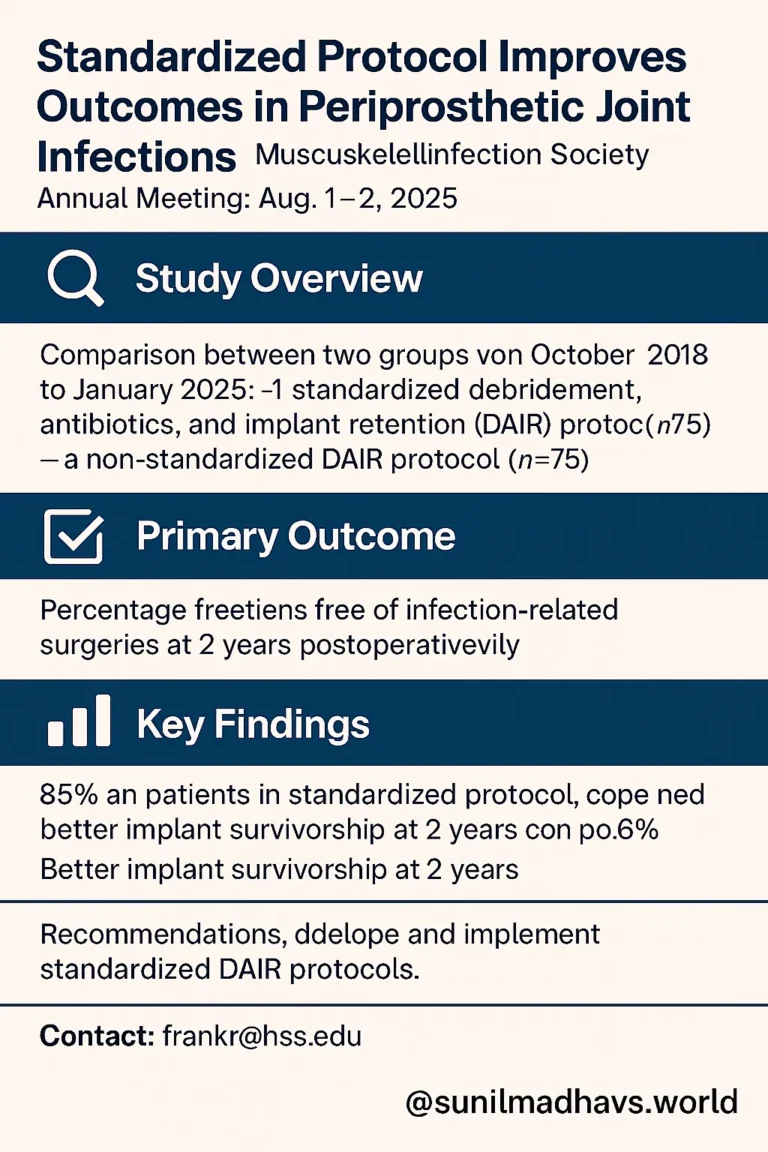A recent study presented at the Musculoskeletal Infection Society Annual Meeting (Aug. 1–2, 2025, Jersey City, N.J.) highlighted the benefits of implementing a standardized protocol for managing periprosthetic joint infections (PJI) following total joint arthroplasty. Researchers found that using a structured approach to debridement, antibiotics, and implant retention (DAIR) resulted in significantly improved patient outcomes compared with non-standardized methods.
Study Overview
Alberto Carli, MD, a hip and knee replacement surgeon at the Hospital for Special Surgery, and colleagues conducted a retrospective review of patients who underwent DAIR procedures for PJI between October 2018 and January 2025. The study analyzed two patient cohorts:
- Standardized DAIR group (n = 75): Procedures followed a defined protocol incorporating two antiseptic solutions — 10% povidone-iodine and Bactisure (Zimmer Biomet).
- Non-standardized DAIR group (n = 75): Procedures performed without a unified protocol, where the choice of antiseptic or steps varied by surgeon preference.
To ensure comparability, patients in both groups were matched by American Society of Anesthesiologists (ASA) scores, chronicity of infection, and whether their surgeries occurred within two years of each other.
Outcomes Measured
The researchers defined primary outcomes as the proportion of patients who avoided any subsequent surgery related to infection within two years of their DAIR procedure.
Secondary outcomes included:
- Length of hospital stay, measured in admission days.
- Rate of wound-related complications, broadly defined as wound dehiscence, requirement of postoperative antibiotics, or reoperation due to wound problems.
Results
Carli reported that patients treated under the standardized protocol had superior outcomes:
- 85% of patients did not require additional infection-related surgery at two years post-procedure.
- In contrast, only 65% of patients in the non-standardized group avoided further surgery.
This difference translated into a significantly higher implant survivorship rate for patients in the standardized DAIR group. The results suggest that the consistent use of antiseptic solutions and a structured, repeatable process can have a meaningful impact on long-term surgical outcomes.
Clinical Implications
Carli emphasized that the findings are less about proving the superiority of one antiseptic solution over another and more about demonstrating the value of systematic standardization. He noted that institutions without a formalized DAIR approach could achieve better patient outcomes by adopting standardized protocols and then tracking outcomes to evaluate effectiveness.
According to Carli, such protocols can help hospitals and surgical teams:
- Deliver more efficient and cost-effective care, by reducing the need for repeat procedures.
- Improve patient safety and satisfaction, through better implant survival and fewer complications.
- Establish benchmarks that allow for continuous quality improvement in the treatment of periprosthetic joint infections.
Expert Recommendation
Dr. Carli concluded that orthopedic surgeons and institutions should actively implement standardized DAIR pathways. By formalizing these processes, healthcare providers may not only improve infection management but also optimize resource utilization and ultimately enhance the quality of patient care.
Source: Sculco P, et al. Paper 1507. Presented at: Musculoskeletal Infection Society Annual Meeting; Aug. 1–2, 2025; Jersey City, N.J.
Disclosure: Dr. Alberto Carli reports consulting for Zimmer Biomet.
For further information, Dr. Carli can be reached via Robin Frank at frankr@hss.edu.


